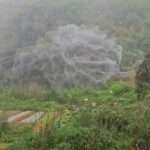Hungry frogs trying to gobble up male wasps have found that their manhoods can carry a nasty sting in the tail, a new study has revealed.
Scientists in Japan – who published a hilarious video documenting their research – have found that a third of male Anterhynchium gibbifrons have genital spikes that can be used as a weapon to fend off predators.
Their short clip shows how a frog in a glass cube eventually gives up on feasting on a wasp as the insect successfully defends itself.

Male wasps are all drones and unlike females have no stingers to inject venom into attackers or prey.
The study – a Kobe University – took 17 tree frogs and fed each of them one live male wasp.
But only the 35 per cent of wasps that fought back using their spikes – of pseudo stingers – survived and made the frogs go hungry,

In a control experiment, 17 male wasps with their genitalia removed were fed to individual frogs and all of them were gobbled down instantly, the study showed,
Professor Shinji Sugiura – associate professor of agriculture at Kobe University – explained: “This study highlights the importance of male genitalia as an anti-predator defence and provides a new perspective for understanding the ecological roles of male genitalia in animals.”
Since the Anterhynchium gibbifrons insects – which are a group of mason wasp species – were only discovered in 2015, crucial information concerning their capabilities had been missing when the Kobe University experts launched their investigation.
The researchers decided to carry out the study when a student, Misaki Tsujii, felt a painful sting as he handled a male of the species.
Spikes found close to other wasp species’ genitals have been analysed before. They are commonly known as pseudo-stingers.

While some female insects use hooks and barbs to wriggle away during mating, no such activities have been detected in the Kobe University ecologists’ laboratory experiment on the Anterhynchium gibbifrons species.
Science Alert magazine quotes the study authors as saying: “Although male wasps are thought to mimic the morphology and behavior of stinging female wasps, we demonstrated that the genital spines of male A. gibbifrons can function to counterattack predators.”
The Kobe University researchers’ study entitled “Male wasp genitalia as an anti-predator defense” has been published in the Current Biology magazine.
Wasps play an important part in the environment as they are engaged pollinators. The pollination of dozens of plants has been found to exclusively depend on wasps.










